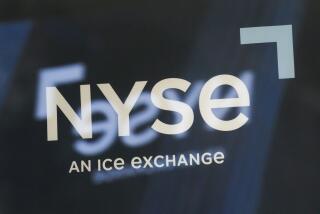Rewards--and Risks--of Buying Foreign Bonds
- Share via
Most savvy U.S. investors would be justifiably suspicious if someone offered them a 9% or 10% yield on a short-term government bond. After all, short-term U.S. treasuries are paying less than half that now.
Still, such yields truly are available on government bonds. The catch is that the bonds aren’t issued by the U.S. government.
Germany, France, Sweden and the United Kingdom are all paying upwards of 9% on short-term obligations. Assuming that you believe these countries are credit-worthy and your time horizon is right, these yields could spell opportunity for income-hungry U.S. investors, industry experts say.
“There are considerably higher yields available (on international bonds) that offer opportunities for even conservative investors,” says Klaus Buescher, managing director of Van Eck Securities in New York.
Buescher, who expects global bonds to be “one of the most exciting investment arenas in the 1990s,” thinks that nearly every investor should consider putting between 5% and 15% of assets in foreign bonds.
Yet, investing in the international bond market bears few similarities to investing at home. The main similarity: Most experts believe that there is little risk that a foreign government, particularly in a developed country, will default on its debts--just like there’s little risk that the U.S. government will stop paying its bills. (Default is a possibility, although still a relatively remote one, when dealing with the debt of small, developing countries, experts say.)
Most international governments also guarantee rates of interest and pay on their debts at regular intervals.
Does that mean that U.S. investors can expect global bond investments to provide a steady stream of income like a U.S. Treasury security? No.
The reason you can’t rely on getting a 9% yield when the bond is paying 9% interest is because of currency fluctuations.
Before you buy a German bond, for example, you (or, more likely, your international bond mutual fund) must trade in U.S. dollars for German currency. When you sell your German bond, you’re paid in German currency as well. If the value of the dollar rises against the German mark, you lose part of your return. If the dollar’s value falls against the mark, you gain.
Consider what happens if your dollar buys 1.4 German marks when you’re buying the bonds but is worth 1.5 German marks when you go to sell.
If you started with an investment of $10,000 (14,000 marks) and earned 9% interest (1,260 marks), you would have 15,260 marks at the end of the year. You want U.S. dollars, though, so you’ve got to trade in the marks at the going rate--1.5 per dollar. You end up with $10,173--a sorry 1.73% return on your money.
What if you bought marks when the dollar was worth 1.5 and sold when it was worth 1.4 marks? Your rate of return soars to almost 17%, allowing you to cash in your $10,000 in German bonds for about $11,679.
Currency values change each day based on inflation rates, monetary policies and economic expectations facing the various governments. Experts maintain that currency fluctuations are among the most daunting risks to international bond investors.
Investors can limit this risk by investing through a mutual fund that “hedges” currency risks or that invests in the bonds of several different nations.
Hedging is a complex strategy that uses option contracts to limit downside risk. The problem is that it costs money and that reduces your return as well.
Some mutual fund managers prefer to simply invest in the debt securities of multiple countries. This limits currency risk somewhat because it is unlikely that you’ll lose the currency fluctuation game in every instance. Still, if you lose on the bulk of the currency bets, it would significantly affect the fund’s overall return.
Another way to limit your risk is to have a flexible, long-term time horizon. Like horses on a merry-go-round, you can be relatively sure that an individual country’s currency will go up and go down.
It’s just a matter of time before the change turns to your advantage. (Of course, this doesn’t hold true if your particular horse is broken. But if it is, you probably had reason to suspect as much before you hopped aboard.)
If you invest in international bonds through a mutual fund, which is probably the easiest and safest way to go, you should match the fund manager’s investment strategy and goals with your own. Also keep an eye on the fund’s “load”--an upfront sales charge--plus its long-term performance and fees. Annual management fees average 1.5% for global bond funds. Some no-load funds also charge annual marketing fees.
Tom Petruno is on assignment.
More to Read
Inside the business of entertainment
The Wide Shot brings you news, analysis and insights on everything from streaming wars to production — and what it all means for the future.
You may occasionally receive promotional content from the Los Angeles Times.










